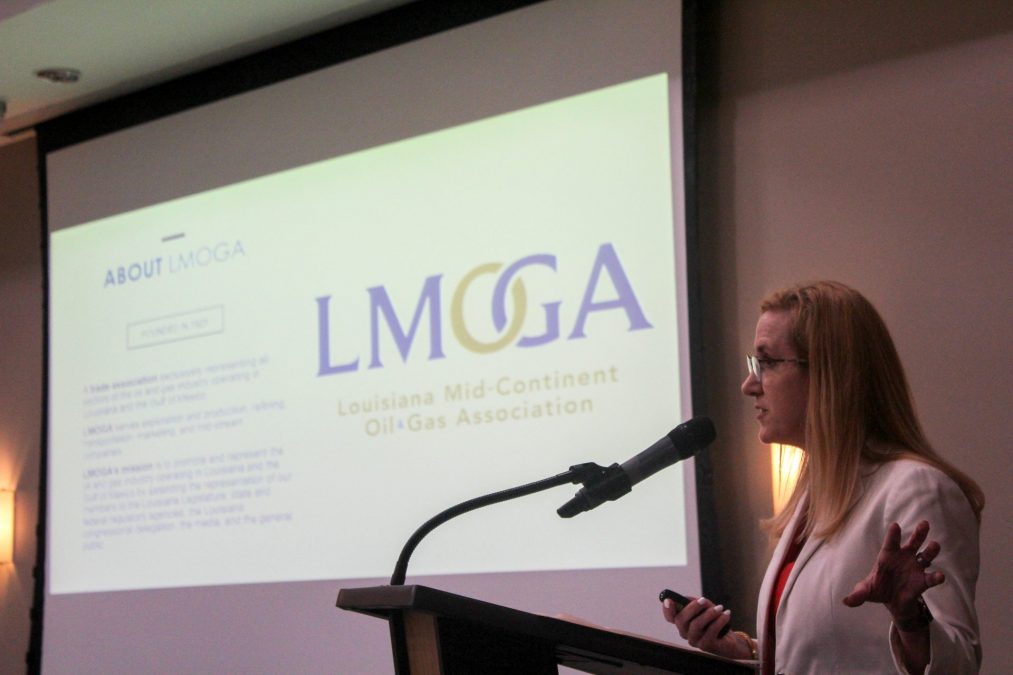
Gallery: Water Officially Turned On at Melvin Johnson Jr. Splash Pad over Memorial Day Weekend
May 31, 2021
Diocese of Houma-Thibodaux announces new pastoral assignments
May 31, 2021The Houma-Terrebonne Chamber of Commerce hosted its monthly General Membership Luncheon Tuesday, May 25 which featured Lori LeBlanc, Vice-President of Louisiana Mid-Continent Oil & Gas Association (LMOGA) and Executive Director of Gulf Economic Survival Team (GEST).
LMOGA is the oldest trade association founded in 1923 that represents all sectors of the oil and gas industry. The organization serves exploration and production, refining, transportation, marketing, and midstream companies. GEST is a member-based non-profit organization whose mission is to promote the significance of the energy industry in the Gulf Region to the U.S. economy, small service companies, and middle-class Americans throughout the nation. These organizations speak as a unified voice on behalf of business organizations to ensure policies and programs support efforts to produce, refine, and transport energy.
LeBlanc shared how the oil and gas industry affects both Louisiana and the nation as a whole. She began, “Louisiana has a long and distinguished history of producing American energy that has provided jobs and opportunities for Louisiana families.”
The first offshore well was drilled 70 years ago, and since then, the Gulf has produced 90% of domestic US crude oil from all of the OCS territories, with approximately 20% of our nation’s oil and gas coming from the Gulf. The state’s first pipeline was built in 1909 that served to transport oil from Caddo Parish to Baton Rouge. Fast forward to today, where there are now over 50,000 of pipeline, which demonstrates the growth of the industry.
Leblanc continued with LMOGA commissioned studies’ results of the State Economic Impact Study to be able to show exactly how much the industry has on the state’s economy. Louisiana is a top 10 oil-producing state and a top 5 natural gas-producing state. The state has 17 oil refineries which account for one-fifth of the nation’s refining capacity. The oil and gas district provided $73 billion to the state Gross Domestic Product (GDP) through all supply chain links. Together, a total of about 250,000 jobs were directly provided by the industry in 2019 and the oil and gas industry accounted for $4.5 billion of state and local tax revenue in 2019.
Locally, Lafourche and Terrebonne parishes have over 5,400 energy employees with an average annual wage of $81,402. This contributes to more than $24 million per year in property taxes and supports more than $440 million in annual wages in Lafourche and Terrebonne parishes. Leblanc said, “As the oil and gas industry has grown over the 100+ years in Louisiana, the state now stands at an important crossroads and the need to recognize that policies have drastic impacts on our industry and our Nation’s security.”
Leblanc then noted where we are headed in the industry. She used the example of the 1970’s gas shortage and the recent pipeline shutoff due to cybersecurity issues. Although the recent brief pipeline shutdown was not a product supply issue, she noted that it may eventually lead to it because, “by the stroke of a pen, and policy changes, it can pose threats to our dependence and our ability to produce safe and reliable American energy.”
Since January of 2021, there have been a few hits to the oil and gas industry. The Keystone XL cancellation, and on the same day, there was the Secretarial Order 3395 under the Department of Interior that required all new oil and gas permits to go to headquarters for review, no longer could they be approved in the region; these are offshore oil and gas permits. Leblanc addressed the luncheon crowd, “the ability to get permits approved is mission critical to ongoing development of multi-billion dollar offshore projects, which in the end, will trickle down and impact everyone in this room.”
She went on to explain the impact of the executive order on the climate crisis where there was a “pause” on new leases in offshore water and federal lands. She quoted the Executive Order, Section 208 which states the “Secretary of the Interior shall pause new oil and natural gas leases on public lands or in offshore waters pending completion of a comprehensive review and reconsideration of Federal oil and gas permitting and leasing practices in light of the Secretary of the Interior’s broad stewardship responsibilities over the public lands and in offshore waters, including potential climate and other impacts associated with oil and gas activities on public lands or in offshore waters.” Also, she used the quote, “Shall consider whether to adjust royalties associated with coal, oil, and gas resources extracted from public lands and offshore waters, or take other appropriate action, to account for corresponding climate costs.” She pointed out, “They did not give us any indication of the length of the pause. What does this mean for the industry?”
As of now, there was one lease sale the state lost out on in March. There usually is two a year, with the next in August, but Leblanc says there is nothing being done to further it. There were key findings in a study commissioned by the American Petroleum Institute (API) on the impact of the federal leasing ban in Louisiana and the Gulf states. The potential impact could possibly mean the loss of over 48,000 jobs and $95 million in state revenue would be at risk, according to the study. America’s energy security would also be at risk; by 2030, offshore production for natural gas would decrease by 68 percent and 44 percent for oil. The U.S. imports from foreign sources would increase by 2 million barrels a day, and through 2030, that would cause the U.S. to spend $500 billion more on energy from foreign suppliers. This in turn would cause the nation’s economy to take a hit. The U.S. gross domestic product would decline by a cumulative $700 billion through 2030, and over $9 billion in government revenue, including funding for state education and conservation programs, would be at risk. This is including over $220 million lost in state revenues for Gulf states due to the loss of federal development in the offshore Gulf of Mexico (GOM). It would cause nearly one million jobs to be lost by 2022, with top production states suffering significant losses including more than 200,000 jobs lost in states reliant on federal development in the offshore GOM.
Leblanc said that environmental progress would also be stalled. Coal use would increase by 15 percent by 2030 and CO2 emissions would increase by an average of 58 million metric tons (MMT) to represent a 5.5 percent increase in the power sector by 2030.
According to the Bureau of Ocean Energy Management (BOEM), the Gulf continues to be the nation’s primary offshore source of oil and gas, generating about 97 percent of all U.S. OCS oil and gas production. Since 2017, the GOM lease sales have generated more than $1 trillion from offshore leasing. Leblanc went on to point out that items people use every day are reliant on the oil and gas industry, “every single drop of a barrel of oil is used to create usable products. In fact, refineries get about 45 gallons of usable petroleum products from a 42 gallon of crude.”
 Leblanc noted that every president since Jimmy Carter has declared energy independence as critical to our national security. The United States is the number one production bringing in 18.60 barrels per day, or 20 percent share of the world’s total.
Leblanc noted that every president since Jimmy Carter has declared energy independence as critical to our national security. The United States is the number one production bringing in 18.60 barrels per day, or 20 percent share of the world’s total.
“While we agree that we all want clean air and we want to take steps to reduce emissions,” Leblanc said, “The EPA has actually shown that we have reduced emissions for all six common pollutants GDP.”
According to studies, “between 1970 and 2017, the combined emissions of the six common pollutants (PM2.5 and PM10,SO10,NOx,VOCs,CO and Pb) dropped by 73 percent. This progress occurred while the U.S. economy continued to grow, Americans drove more miles and population and energy use increased.” A study conducted under the Obama administration concluded that GHG emissions would be higher if BOEM were to have no lease sales. Leblanc said, “If we cancel lease sales, we would have to import foreign oil to offset the reduced OCS supply, resulting in an increased GHG emissions to exploration, development, production, and transportation of oil from international sources which are more carbon intensive. The Gulf of Mexico is the safest and cleanest oil we can produce anywhere in the world.”

She said, “In fact, this was further substantiated by a global economic firm, Wood Mackenzie. The U.S. GOM has the 2nd lowest carbon emissions, and it would probably be in the first spot if they factored in shipping and transportation costs from Saudi Arabia.”


Leblanc concluded by reiterating that Louisiana is our home. “It’s a place where we are proud to produce energy while also protecting our natural resources. The industry is part of restoring our coastal wetlands,” she said. “We work here, we live here, and we want to protect it for many years to come. Now more than ever, we need to be a strong voice for the industry.”
To get updates from GEST, you can join today by texting GULFSTRONG to 52886 or email lori@gulfeconomicsurvival.org.
By Heidi Guidry
Feature photo by Tyler Duplantis, Houma-Terrebonne Chamber of Commerce








